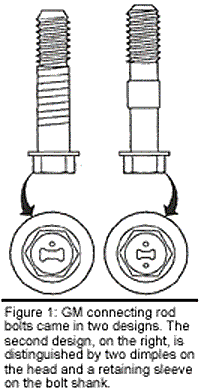Engine Builders: The AERA Technical Committee offers the following information for 1997-2002 GM 4.8, 5.3, 5.7 & 6.0L VIN V, T, G & U engines. These engines were manufactured with two different design connecting rod bolts beginning in 1999. Either design bolt, when used in pairs and properly tightened, may be used on a single connecting rod.
The service manual did not reflect that information until the 2000 model year publication.

Important: When replacing the connecting rod bolts, both bolts MUST be of the same design for each connecting rod assembly. The use of different design connecting rod bolts on the same connecting rod may lead to uneven clamp loads and/or connecting rod bearing bore distortion. The different bolt designs require different torque values.
Refer to Figure 1 to identify the type of connecting rod bolt being used before attempting to tighten.
The first design connecting rod bolt is identified by a single dimple mark on the head and has no retaining sleeve on the bolt shank. To properly tighten the first design bolts, torque to 15 ft.lbs., then bolt 60













